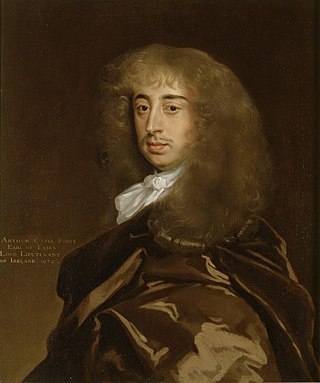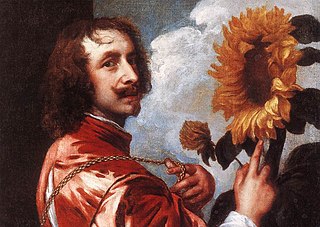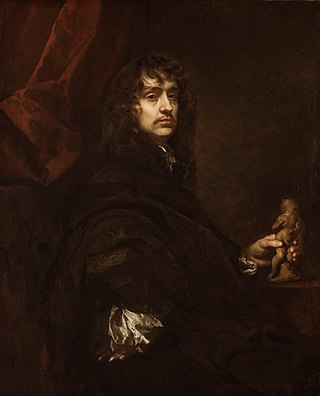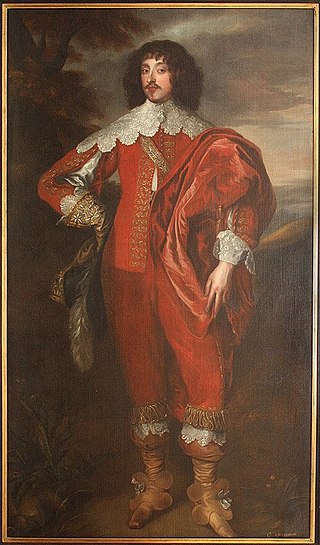
The Capel Family is one of the few group portraits by Cornelius Johnson, who is better known for head and shoulders portraits.

The Capel Family is one of the few group portraits by Cornelius Johnson, who is better known for head and shoulders portraits.
The portrait was painted in oil on canvas around 1641 and is 63 inches (160 cm) by 102 inches (260 cm).
It shows Arthur Capel, his wife, Elizabeth Morrison and their children, Mary, Henry, Charles, Elizabeth and Arthur. In the background is the garden at Little Haddon.
It is on display at the National Portrait Gallery in London. [1] The portrait was probably commissioned to mark Capel's appointment as Baron Capel in 1641. [2]
It was bought from Leggatt Brothers in 1970 for £28,350, £3,000 of which was contributed by ArtFund. The provenance was given as Cassiobury, the family home of the earls of Essex. [3] C. H. Collins Baker notes that it was at Cassiobury in 1912. [4]
The arrangement of the figures is greatly influenced by Van Dyck's portrait of the family of King Charles I [5] and by Honthorst's portrait of the Buckingham family. [6]
It has been used to illustrate differences in gender status in England in the 16th and 17th century. [7] [8]

Arthur Capell, 1st Earl of Essex, PC, also spelt Capel, of Cassiobury House, Watford, Hertfordshire, was an English statesman.

Earl of Essex is a title in the Peerage of England which was first created in the 12th century by King Stephen of England. The title has been recreated eight times from its original inception, beginning with a new first Earl upon each new creation. Possibly the most well-known Earls of Essex were Thomas Cromwell, chief minister to King Henry VIII, and Robert Devereux, 2nd Earl of Essex (1565–1601), a favourite of Queen Elizabeth I who led the Earl of Essex Rebellion in 1601.

Sir Anthony van Dyck was a Flemish Baroque artist who became the leading court painter in England after success in the Spanish Netherlands and Italy.

Thomas Howard, 14th Earl of Arundel KG, was an English peer, diplomat and courtier during the reigns of King James I and King Charles I, but he made his name as a Grand Tourist and art collector rather than as a politician. When he died he possessed 700 paintings, along with large collections of sculptures, books, prints, drawings, and antique jewellery. Most of his collection of marble carvings, known as the Arundel marbles, was eventually left to the University of Oxford.

Arthur Capell, 1st Baron Capell, of Hadham Hall and Cassiobury House, Watford, both in Hertfordshire, was an English politician who sat in the House of Commons from 1640 until 1641 when he was raised to the peerage as Baron Capell. He supported the Royalist cause in the Civil War and was executed on the orders of parliament in 1649.

William Capell, 3rd Earl of Essex, was an English courtier and diplomat.

Little Hadham is a village and civil parish in the district of East Hertfordshire, Hertfordshire, England. At the census of 2001 it had a population of 1,081, increasing to 1,153 at the 2011 Census. It is bypassed by the A120 road, which connects it to the nearby town of Bishop's Stortford. The civil parish includes the hamlets of Bury Green, Church End, Cradle End, Green Street and Hadham Ford. Little Hadham, together with the neighbouring village of Much Hadham, are collectively known as The Hadhams.

Cassiobury House was a country house in Cassiobury Park, Watford, England. It was the ancestral seat of the Earls of Essex. Originally a Tudor building, dating from 1546 for Sir Richard Morrison, it was substantially remodelled in the 17th and 19th centuries and ultimately demolished in 1927. The surrounding Cassiobury Park was turned into the main public open space for Watford.

Sir Peter Lely was a painter of Dutch origin whose career was nearly all spent in England, where he became the dominant portrait painter to the court. He became a naturalised British subject and was knighted in 1679.

Marcus Gheeraerts was a Flemish artist working at the Tudor court, described as "the most important artist of quality to work in England in large-scale between Eworth and van Dyck" He was brought to England as a child by his father Marcus Gheeraerts the Elder, also a painter. He became a fashionable portraitist in the last decade of the reign of Elizabeth I under the patronage of her champion and pageant-master Sir Henry Lee. He introduced a new aesthetic in English court painting that captured the essence of a sitter through close observation. He became a favorite portraitist of James I's queen Anne of Denmark, but fell out of fashion in the late 1610s.
Sir Oliver Nicholas Millar was a British art historian. He was an expert on 17th-century British painting, and a leading authority on Anthony van Dyck in particular. He served in the Royal Household for 41 years from 1947, becoming Surveyor of The Queen's Pictures in 1972. He was the first Director of the Royal Collection from 1987. He served in both offices until his retirement in 1988.

George Capel-Coningsby, 5th Earl of Essex FSA was an English aristocrat and politician, and styled Viscount Malden until 1799. His surname was Capell until 1781.

Sir Charles Morrison, 1st Baronet of Cashiobury in Watford, Hertfordshire, was an English politician who sat in the House of Commons at various times between 1621 and 1628.

Charles I with M. de St Antoine is an oil painting on canvas by the Flemish painter Anthony van Dyck, depicting Charles I on horseback, accompanied by his riding master, Pierre Antoine Bourdon, Seigneur de St Antoine.

Watford Museum is a local museum in Watford, Hertfordshire, in the United Kingdom. It is owned by Watford Borough Council and is located on the Lower High Street in Watford.
Arthur Algernon Capell was an English aristocrat who succeed to the title Earl of Essex in 1839.
George Devereux de Vere Capell, 7th Earl of Essex, was a British aristocrat. He succeeded to the title Earl of Essex in 1892.

John Weesop or Jan Weesop was a portrait painter presumed to be of Flemish descent who is now only known for his works produced in the 1640s in England. His English patrons were predominantly prominent members of the royalist aristocracy.

William Villiers, 2nd Viscount Grandison was an Irish peer and Royalist soldier who was fatally wounded during the First English Civil War in 1643.
Algernon George de Vere Capell, 8th Earl of Essex was a British aristocrat who succeeded to the title Earl of Essex in 1916 and became an amateur actor.